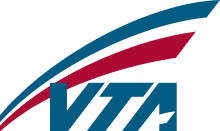Board of directors
Starting from January 1, 1995, [39] : 9 the Santa Clara VTA special district is governed by a board of directors with 12 voting members [40] composed of political leaders at the city and county level, including the Santa Clara County Board of Supervisors, San Jose City Council, and other cities including Campbell, Cupertino, Fremont, Gilroy, Los Altos, Los Altos Hills, Los Gatos, Milpitas, Monte Sereno, Morgan Hill, Mountain View, Palo Alto, Santa Clara, San Martin, Saratoga, and Sunnyvale.
Of the eighteen members, fifteen are drawn from city councils and three are county supervisors; twelve are voting members and six are alternates. [41] Five of the fifteen board members from city councils are from San Jose, which has led to criticism that the board is too heavily weighted towards one city. [42] [43]
Under the original proposal to form VTA in 1994, a sixteen-member board was proposed: five members directly elected, one each from the five County Supervisorial Districts; and eleven appointed from elected bodies (city councils or the county board of supervisors). The implementing legislation changed this structure to a nineteen-member board: twelve voting members, five alternates, and up to two ex-officio members, who serve as VTA's representatives to the Bay Area Metropolitan Transportation Commission. [44] : 2 For the first ten years (1995–2004), the twelve voting members were selected as: [44] : 2
- 5 from the San Jose City Council
- 5 from other city councils in Santa Clara County:
- 1 from Sunnyvale for 8 of 10 years; the remaining 2 years are filled by a member from the other Central district cities (Los Altos, Los Altos Hills, Mountain View, or Palo Alto)
- 1 from Santa Clara for 8 of 10 years; the remaining 2 years are filled by a member from the other Central district cities
- 1 from the Central district cities, on a rotating basis
- 1 from the South/Eastern district cities (Gilroy, Milpitas, Morgan Hill or San Martin), on a rotating basis
- 1 from the Western district cities (Campbell, Cupertino, Los Gatos, Monte Sereno, or Saratoga), on a rotating basis
- 2 County Supervisors
Each Board of Directors member serves a two-year term. For the non-rotating members (San Jose, Sunnyvale, Santa Clara, and County Supervisor), each member may serve multiple terms. [44] : 2
From 2004 to 2009, the Board had similar requirements with five San Jose City Councilmembers and two County Supervisors; the five non-San Jose city-level Board members were selected as: [45] : 2
- 1 from the South/Eastern district cities (Gilroy, Milpitas, Morgan Hill or San Martin), on a rotating basis
- 1 from the Western district cities (Campbell, Cupertino, Los Gatos, Monte Sereno, or Saratoga), on a rotating basis
- 3 from the Central district cities (Sunnyvale, Santa Clara, Los Altos, Los Altos Hills, Mountain View, or Palo Alto), on a rotating basis
In June 2004, a Santa Clara County Grand Jury criticized the governance structure, calling it "too large, too political, too dependent on staff, too inexperienced in some cases, and too removed from the financial and operational performance of VTA." [44] : 4 Since VTA board members are required to be elected officials, they must juggle their other duties in addition to VTA. The Grand Jury recommended that the VTA board be shrunk to five to seven members, with members either appointed solely for transportation issues or directly elected by the voters. [44] Grand juries in 2009 [45] and 2019 have echoed similar complaints. [39]
Assemblymember Marc Berman (D-Menlo Park) introduced AB 1091 on February 18, 2021, [46] which would reduce the size of the board to nine members, of which five would be appointed by the County Supervisors, two would be from San Jose, and two would be from the remaining cities, split between the northern cities (one member from Palo Alto, Mountain View, Los Altos, Los Altos Hills, Sunnyvale, or Milpitas) and the southern cities (one member from Santa Clara, Campbell, Cupertino, Saratoga, Los Gatos, Monte Sereno, Morgan Hill, San Martin or Gilroy). Instead of the current structure, which appoints Board members from elected officials, under Berman's proposed bill, the Board members would be appointed from the public and serve four-year terms. [42] AB 1091 faced significant opposition from the San Jose City Council [47] and was tabled in May. [48]
Berman followed up by re-introducing the VTA Board reform bill as AB 2181 on February 15, 2022. [49] AB 2181 passed the Assembly on a 69–2 vote in May, with Assemblymembers Ash Kalra and Mark Stone opposed. [50] Current and former VTA Board members criticized AB 2181 as not sufficiently ensuring representation from smaller cities and not addressing the root causes of VTA's low ridership. [50]









